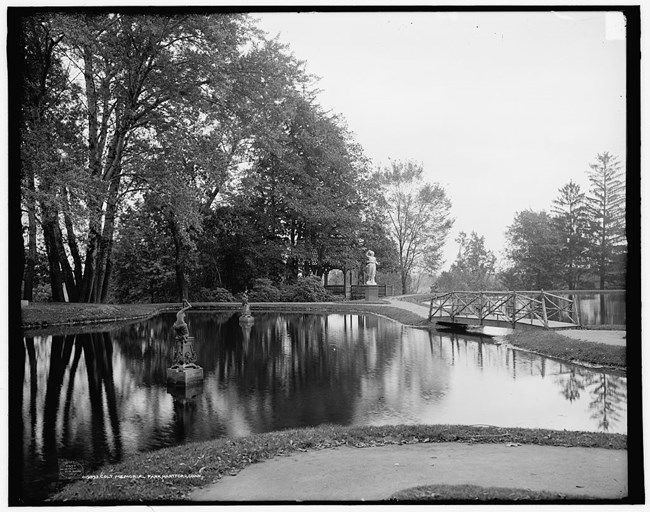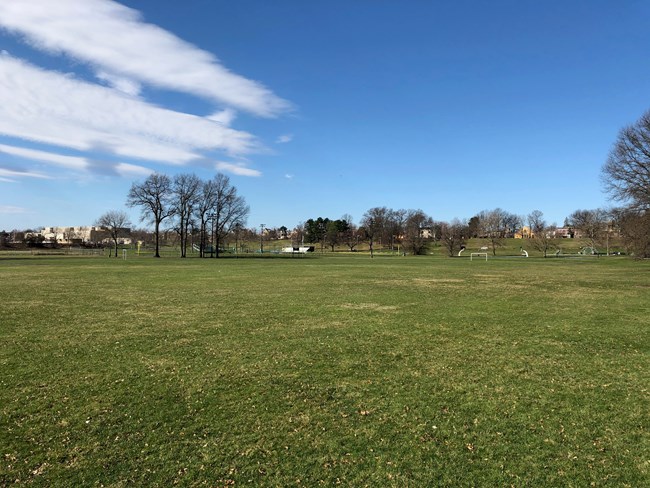|
The park is managed by the City of Hartford and is open to the public from dawn to dusk.
Located behind the Colt family home, Armsmear, expansive grounds allowed for relaxation and an escape from the urban center, not only for the Colts but also for the employees of Colt’s Patent Firearms Manufacturing Company. The grounds, during the residence of the Colts, were extravagant and modeled in High Victorian style. The 105 acres designed by Cleveland and Copeland, were planned in a manner that allowed family, the factory workers, and guests to escape from the hustle and bustle of the 19th century and reconnect with nature. Manicured grounds in the 1800s, which was a popular trend, was a sign of royalty or high class. This translated well to the new money lifestyle of the Colts and industrialists. The grounds took one out of the urban center and transported them to another world. 
Photo Credit: Library of Congress, Prints & Photographs Division/Detroit Publish Company Rare plants and tropical fruits such as pineapples, grapes, oranges, bananas and figs were grown in greenhouses. The gardens were extremely efficient, and produce was grown year-round. It was not uncommon to see exotic animals, such as Chinese pheasants, ducks, swans, and peacocks roaming the grounds. The Colt Estate had a deer park, located behind Armsmear, which the City of Hartford inherited after Elizabeth’s passing.
Samuel, ever looking to the future, built a lake using an innovative pipe system. The system pumped water in from the Connecticut River through Coltsville, supplying the lake and two ponds with flowing water. The lake, over thirty feet deep in places, had black bass and Chinese carp. It offered various recreation opportunities including row boating, ice skating, and fishing. A summer pavilion near the lake allowed visitors to sit and enjoy a view of the grounds.

Photo Credit: Library of Congress, Prints & Photographs Division/Detroit Publish Company Today, nestled under a single oak tree, the Samuel Colt Monument stands as a reminder of Samuel Colt’s legacy. Here, stands a testament to the man who greatly impacted Hartford and the United States through his technological innovations and the development of an industrial village. The memorial was commissioned by Elizabeth Hart Jarvis Colt and completed in 1906. Just down the hill from the family home, lived the Colt gardener. The Colt Gardener’s Cottage was built around 1860 and provided housing to the Colt gardener and family. This small house was nestled under trees and tucked back from the main carriage path giving the family privacy. Near the Gardener’s Cottage, but closer to the main carriage path, is the Colt Carriage House. The stable, built around the same time as the Gardener’s Cottage, was where the Colts stored their carriages and boarded their horses. The Carriage House had cock fighting rings too. Both the Gardener’s Cottage and Carriage House have undergone structural changes, but elements from the Colts can still be found in the architecture. 
Photo Credit: NPS/Eric Ott The meadows were developed for recreation grounds, a fence was erected, tennis courts, a bowling green, playgrounds, running tracks, and baseball fields were added. The carriage path was expanded, the greenhouses were removed, and the area was developed into school garden plots. In 1952, the reflecting pond and statuary were filled and became a lawn.
Colt Park continued to be a gathering place for the residents of Hartford as numerous events were held on the grounds including baseball games, boxing events, horse races, concerts at the bandshell (built in the early 1900s), dances and numerous community events. The Park was a gathering place and it brought life and enjoyment to the community, as it does now. Today Colt Park has basketball and handball courts, soccer, baseball, softball and football fields, two swimming pools, a playground, and a walking path. While the park doesn’t look the same, it serves its original function allowing individuals to reconnect with nature and each other. In 1976 Colt Park was added to the National Historic Register of historic Places and in 2008, it became a contributing site to the Coltsville Historic District which is registered as a National Historic Landmark District. In 2014, the United States Congress authorized creation of the Coltsville National Historical Park. 
Photo Credit: NPS/Dani Beekman |
Last updated: April 7, 2021
